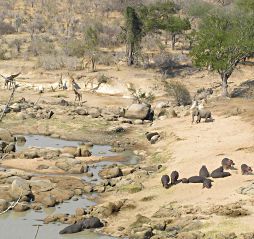Main content:
Maintaining Biodiversity

This is the 2007 draft on biodiversity. You will get the newest version here.
Biodiversity includes diversity of species, habitats and genes. It is important for stability and adaptability of ecosystems, and it is in increasing demand as a source of medicines and other commercial material. Biodiversity is also a foundation of soil productivity, forests and fish stocks.
Affected people and foundations of life: 12% of bird species, 23% of mammal species, and at least 32% of amphibian species are threatened with extinction ( 2005). Worldwide only 14 animal species account for 90% of all livestock production and only 30 crops dominate agriculture ( 2007, 171). About 1 billion people live a subsistence lifestyle, so the loss of ecosystem productivity can rapidly lead to malnutrition and increased susceptibility to diseases (UNEP 2007, 180).
The global risk of destabilization of ecosystems has a high potential for damage, as well as a high probability of occurrence. The risk of anthropogenic affects on mass developments of species also has a high potential damage, but an unknown probability. ( 1998, 62.) Agricultural expansion, including seeding very few crop species and using pesticides, is one of the major drivers of biodiversity loss, just like nutrient pollution, climate change and the invasion of species caused by global transport and travelling.
Targets/goals: reducing significantly, by 2010, the rate of loss of biodiversity (base year: 1990; World Summit on Sustainable Development: 2002, § 42, and 2006a, 6).
Trend: − 12 of 14 indicators for biodiversity adopted by a Conference of the Parties of the Convention on Biological Diversity show a negative trend. The only positive indicator is the coverage of protected areas, which has increased to 13% of the world’s land area. But not all of the protected areas are effectively managed. ( 2006, 4.) The Living Planet Index, aggregating trends in population size of some 3 000 wild populations of vertebrates, shows a consistent decline in average species abundance of about 40% between 1970 and 2000. Inland water species have declined by 50%, while marine and terrestrial species both have declined by around 30%. The index is calculated as an average percentage of the population size of individual wild species (taking 1970 as index base year). (CBD 2006, 25; 2006, 4) In the Caribbean, average hard coral cover has declined from about 50% to 10% in the last three decades (CBD 2006, 24).
Measures: Measures to be enhanced include establishing more protected areas (especially in "hot spots" that host a lot of species) and improving their management, using more environmentally sound methods in agriculture, storing seeds and genes, and protecting species threatened by extinction locally or due to trade, and sustainable use generally (Convention on Biological Diversity 1992, biodiv.org).
Annotations: For numeric names the short scale is used:
1 billion = one thousand million = 109 = 1 000 000 000
Sources
- CBD 2006 – Secretariat of the Convention on Biological Diversity: Global Biodiversity Outlook 2.

 Montreal.
Montreal. - MA 2005 – Millennium Assessment: Ecosystems and Human Well-being; Synthesis; A Report of the Millennium Ecosystem Assessment.
 (Written on behalf of the UN, coordinated by UNEP.) Washington.
(Written on behalf of the UN, coordinated by UNEP.) Washington. - UN 2002 – United Nations, World Summit on Sustainable Development: Plan of Implementation.


- UN 2006a – United Nations: Report of the Secretary-General on the work of the Organization. General Assembly, Official Records, Sixty-first Session, Supplement No. 1 (A/61/1).


- UNEP 2007 – United Nations Environment Programme: Global Environment Outlook 4.


- WBGU 1998 – German Advisory Council on Global Change (Wissenschaftlicher Beirat Globale Umweltveränderungen der Bundesregierung): World in Transition: Strategies for managing global environmental risks.

 Annual report 1998. Berlin, Heidelberg, New York, et al.: Springer, 2000 [publishing year of English version].
Annual report 1998. Berlin, Heidelberg, New York, et al.: Springer, 2000 [publishing year of English version]. - WWF 2006 – Worldwide Fund for Nature: Living Planet Report 2006.


Draft (2007)
Photo credit: © Lauren Humphries/NBII.gov
